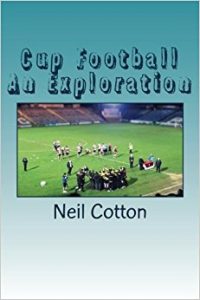Book Review: Cup Football An Exploration by Neil Cotton
 Author Neil Cotton is a self-confessed Cup-fanatic, which came about from the first ever football match he attended, which was a 1994 Coca-Cola League Cup at The Dell between Southampton and Huddersfield Town.
Author Neil Cotton is a self-confessed Cup-fanatic, which came about from the first ever football match he attended, which was a 1994 Coca-Cola League Cup at The Dell between Southampton and Huddersfield Town.
Cotton’s proof of this love affair opens his book, Cup Football An Exploration:
“Alone on Platform One of a deserted Fratton Station isn’t a place I’d ordinarily choose to be at 10pm on a weekday night. It’s cold…and salvation in the form of my train home is forty minutes away. Why am I here? The blame lies squarely at my love of cup football in all forms. This was the impulse which brought me to Portsmouth’s Fratton Park to see Gosport Borough taking on Sholing in the Final of the (2014/15) Hampshire Senior Cup, an occasion few football fans – even of the clubs concerned – would cross for.”
This authors dedication and fascination with the cup format comes across in this informative, well researched and thought provoking book. Whilst there will other books which offer definitive guides and records to cup competitions, this is an interesting view across the cup spectrum whether that be County Cups or World Cup Finals.
In the early parts of this book, Cotton talks about the significance of the early County Football Associations and the importance of the County Cups and the World’s most famous competition, the FA Cup, before the formation of the Football League. He also interestingly highlights the social importance of the numerous Hospital Cups that took place, some of which have survived to this day.
As well as detailing the introduction of the League Cup, Cotton also touches on competitions from the 70s and 80s which saw companies such as Texaco and Watney’s become early sponsors of new cups. There are also looks at formats such as the Anglo-Italian Cup (in both its professional and non-league guise), and the Anglo-Scottish Cup, which will be remembered by fans of a certain age.
The study though isn’t confined to these shores, as the author looks at the significance of a post-war Europe and the introduction of the various club competitions, the European Cup, European Cup Winners Cup and Inter-City Fairs Cup and how these have changed in the modern era.
Cotton finishes the book with a chapter titled, The End? It is an interesting conclusion to the book and this review won’t detail here his suppositions, and hope instead that readers will but the book to discover them for themselves. This is a recommended read for anyone interested in the game looking for an overview of the development of Cup Football.
Note: Self-publishing is a brave and sometimes costly enterprise. However, it can lead to some issues with respect to the amount of time attributed to things such as the area of proofreading. In the case of Cotton’s book, a more detailed proofread would have picked up on the typos and, from a personal perspective, the overuse of the semi-colon. In addition, the inclusion of a chapter index and a reference section would have been beneficial.